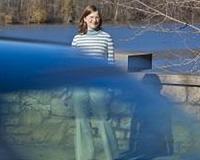| . |  |
. |
London, UK (SPX) Jul 02, 2010 Research by scientists at Queen Mary, University of London has found that a predicted rise in global temperature of 4 degrees C by 2100 could lead to a 13% reduction in ecosystems' ability to absorb carbon dioxide (CO2) from the atmosphere. Writing in Philosophical Transactions of the Royal Society B, the scientists describe a new model to predict how the carbon storage capacity of ecosystems would respond to future global warming. They tested their predictions against data collected from experimental ponds which were warmed to simulate global warming, revealing a 13% reduction in the amount of CO2 absorbed by the warmed ecosystems. Lead author of the Philosophical Transactions paper, Gabriel Yvon-Durocher from Queen Mary's School of Biological and Chemical Sciences said: "The beauty of this model is in its simplicity. We made our prediction based on just two parameters - the 'activation energies' for photosynthesis and respiration, and the increase in temperature which exactly predicted the changes observed in our experiment." He explains: "Photosynthesis by plants absorbs CO2 while respiration by animals returns CO2 to the atmosphere. Respiration has a higher 'activation energy' than photosynthesis meaning that it increases more rapidly with increasing temperature. So if climate change raises environmental temperatures, the balance between respiration and photosynthesis in the ecosystem will change, favouring more respiration and less CO2 absorption." The work is complemented by another paper published this month by Dr Guy Woodward and other Queen Mary colleagues in the journal Global Change Biology. This research compared animals living in 15 similar Icelandic streams, a rare long-term 'natural experiment' in which geothermal activity heats some streams up to 45 degrees C. The unique situation meant researchers could study how temperature affects Arctic ecosystems, where climate change is predicted to cause a rise of around 7.5 degrees C within the next century. Dr Woodward says: "We found dramatic changes in the type and number of species in cold streams compared with the warmer ones. It was notable that fish and other larger predatory animals were absent from the coldest streams. We saw longer food-chains, with predators becoming bigger and more abundant as temperatures increased from 5 degrees C to 25 degrees C. We also have more recent (as yet unpublished) data collected from the Icelandic streams by colleagues at the Macaulay Institute that show similar patterns to those seen in the experimental ponds: namely the warmer streams emitted far more CO2 than the cooler streams and acted as sources of carbon, rather than sinks."
Share This Article With Planet Earth
Related Links Queen Mary, University of London The Air We Breathe at TerraDaily.com
 Aggressive Action To Reduce Soot Emissions Needed
Aggressive Action To Reduce Soot Emissions NeededPrinceton NJ (SPX) Jun 30, 2010 Without aggressive action to reduce soot emissions, the time table for carbon dioxide emission reductions may need to be significantly accelerated in order to achieve international climate policy goals such as those set forth in last December's Copenhagen Accord, according to "Assessing the climatic benefits of black carbon mitigation," a study published online June 21 in the Proceedings of the ... read more |
|
| The content herein, unless otherwise known to be public domain, are Copyright 1995-2010 - SpaceDaily. AFP and UPI Wire Stories are copyright Agence France-Presse and United Press International. ESA Portal Reports are copyright European Space Agency. All NASA sourced material is public domain. Additional copyrights may apply in whole or part to other bona fide parties. Advertising does not imply endorsement,agreement or approval of any opinions, statements or information provided by SpaceDaily on any Web page published or hosted by SpaceDaily. Privacy Statement |